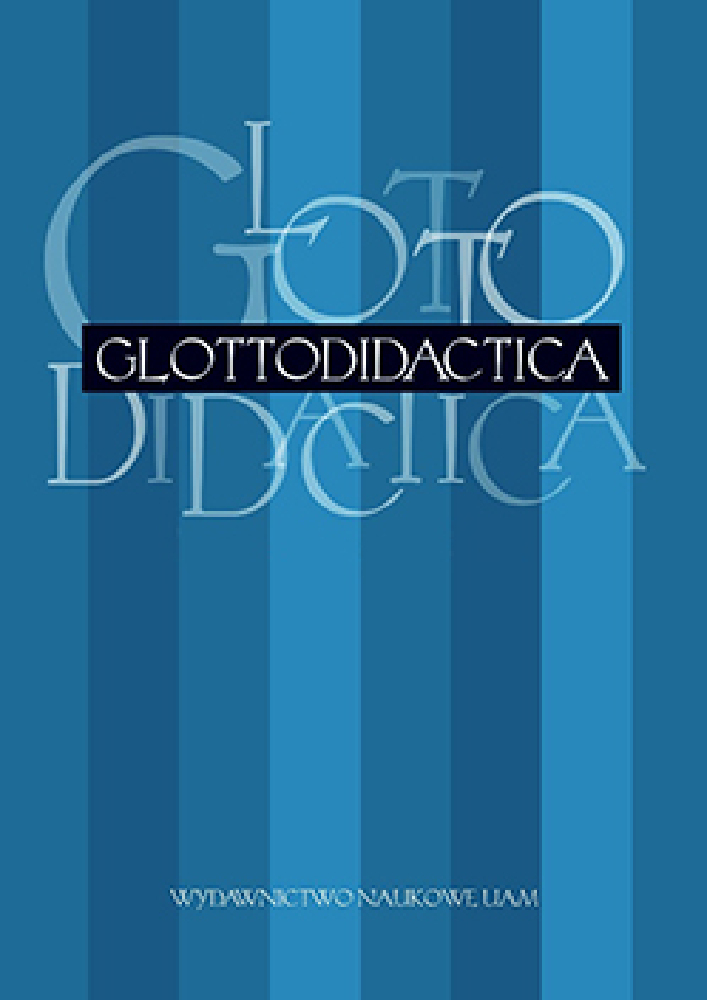Abstrakt
The paper analyses sample drawings produced by blind children. The focus will be put on the representation of concepts. Major findings gathered in the discussion section show that sight plays complementary rather than primary role in the process of conceptual development, which supports other research in the field of blindness studies conducted so far.Bibliografia
Bussmann, H., Gregory, T., Kazzazi, K., 1996. Routledge dictionary of language and linguistics. London–New York: Routledge.
Cratty, B., Sams, T., 1968. The body-image of blind children. New York: American Foundation for the Blind.
Cutsforth, T., 1932. The unreality of words to the blind. In: Teachers Forum 4, 86-89.
DeMott, R., 1972. Verbalism and affective meaning for blind, severely visually impaired, and normally sighted children. In: New Outlook for the Blind 66 (1), 1-8.
Dokecki, P., 1966. Verbalism and the blind. A critical review of the concept and the literature. In: Exceptional Children 32, 525-530.
Dromi, E., 1999. Early lexical development. In: Barrett, M. (ed.). The development of language. Hove–New York: Psychology Press, 99-126.
Dunlea, A., 1989. Vision and the emergence of meaning. Blind and sighted children’s early language. Cambridge: Cambridge University Press.
Gleitman, L., 1990. The structural sources of verb meaning. In: Language Acquisition 1, 3-55.
Heller, M.A., 2002. Tactile picture perception in sighted and blind people. In: Behavioral Brain Research 135, 65-68.
Kennedy, J., 1993., Drawing and the blind. New Haven–London: Yale University Press.
Klimasiński, K., 1989. Organizacja czynności poznawczych przy głębokim defekcie wzroku. Kraków: Wydawnictwo Uniwersytetu Jagiellońskiego.
Landau, B., 1983. Blind children’s language is not meaningless. In: Mills, A.E. (ed.). Language acquisition in the blind child: normal and deficient. London: Croom Helm, 62-76.
Landau, B., Gleitman, L., 1985. Language and experience. Evidence from the blind child. Cambridge, Massachusetts–London: Harvard University Press.
McLinden, M., McCall, S., 2002. Learning through touch. Supporting children with visual impairment and additional difficulties. London: David Fulton Publishers.
Majewski, T., 1983. Psychologia niewidomych i niedowidzących. Warszawa: Państwowe Wydawnictwo Naukowe.
Margolis, E., Laurence, S., 2006. Concepts. In: Brown, K. (ed.). Encyclopaedia of language and linguistics. Elsevier Science, 817-820.
Millar, S., 1994. Understanding and representing space. Oxford: Oxford University Press.
Perez-Pereira, M., Conti-Ramsden, G., 1999. Language development and social interaction in blind children. Hove–New York: Psychology Press.
Recchia, S., 1997. Play and concept development in infants and young children with severe visual impairments: a constructivist view. In: Journal of Visual Impairment and Blindness, 91, 401-406.
Rosel, J.A., Caballer, P.J., Olivier, J.C., 2005. Verbalism in the narrative language of children who are blind and sighted. In: Journal of Visual Impairment and Blindness, 413-425.
Sękowska, Z., 1974. Kształcenie dzieci niewidomych. Warszawa: Polskie Wydawnictwo Naukowe.
Szczechowicz, A., 1976. Swoistość kształtowania się pojęć u dzieci niewidomych. In: Klimasiński, K. (ed.). Procesy poznawcze a defekty sensoryczne. Materiały I Krajowego Sympozjum Psychologii Defektologicznej. Warszawa: Instytut Psychologii, 86-99.
Licencja
Autorzy
Autorzy tekstów przyjętych do publikacji w czasopiśmie Glottodidactica są zobowiązani do wypełnienia, podpisania i odesłania na adres redakcji umowy o udzielenie nieodpłatnej licencji do utworów, z zobowiązaniem do udzielania sublicencji CC.
Zgodnie z umową, autorzy tekstów opublikowanych w czasopiśmie Glottodidactica udzielają Uniwersytetowi im. Adama Mickiewicza w Poznaniu niewyłącznej i nieodpłatnej licencji oraz zezwalą na użycie sublicencji Creative Commons Attribution-NoDerivatives 4.0 International (CC BY-ND 4.0).
Autorzy zachowują prawa do dalszego, swobodnego rozporządzania utworem.
Użytkownicy
Zainteresowani użytkownicy internetu uprawnieni są do korzystania z utworów opublikowanych od 2015 roku w Glottodidactica pod następującymi warunkami:
- uznanie autorstwa - obowiązek podania wraz z rozpowszechnionym utworem, informacji, o autorstwie, tytule, źródle (odnośniki do oryginalnego utworu, DOI) oraz samej licencji;
- bez tworzenia utworów zależnych - utwór musi być zachowany w oryginalnej postaci, nie można bez zgody twórcy rozpowszechniać np. tłumaczeń, opracowań.
Do wszystkich tekstów opublikowanych przed 2015 r. prawa autorskie są zastrzeżone.
Inne
Uniwersytet im. Adama Mickiewicza w Poznaniu zachowuje prawo do czasopisma jako całości (układ, forma graficzna, tytuł, projekt okładki, logo itp.).




